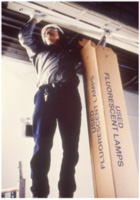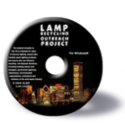
Laws and Regulations
Information on Spent Lighting
A Summary of the Universal Waste Rule and RCRA Subtitle C Hazardaous Waste Regulations fo Businesses.
- The Federal Rules
- RCRA and UWR Definitions
(see below) - Who does this rule apply to?
- Where can the waste go?
- How does using the UWR to recycle simplify disposal?
State Strigency Comparisons
State-by-State Information
EPA Fact Sheet
Transportation Issues
RCRA and UWR Definitions (as they apply to lamps)
The following definitions are summaries of those found in the Code of Federal Regulations (CFR) as they apply to mercury-containing lamps. Also cited are specific sections in the CFR where official definitions are found.
Lamp or Universal Waste (UW) Lamp
The bulb or tube portion of an electric lighting device. A lamp is specifically designed to produce radiant energy, most often in the ultraviolet, visible, and infrared regions of the electromagnetic spectrum. Examples of common universal waste electric lamps include, but are not limited to, fluorescent, CFL, high intensity discharge, neon, mercury vapor, high pressure sodium, and metal halide lamps. The lamp definition is found at (40 CFR 273.9).All fluorescent lamps contain some amount of mercury. Unless otherwise marked, these lamps will likely fail EPA’s Toxicity Characteristic Leaching Procedure (TCLP) for mercury, and unless exempted, they must be handled as a hazardous waste. Depending on date of manufacture, some lamps that pass the TCLP test may be marked in green, either as an etch on the glass, or as a colored base. In some circumstances these lamps may be handled as ordinary solid waste. All mercury-containing lamps, whether hazardous or not, will release mercury into the environment when broken outside of a controlled recycling process. EPA encourages recycling all mercury-containing lamps.
Universal Waste Handler or Handler
Generally speaking, anyone who produces, stores, collects, or accumulates universal waste, such as mercury-containing lamps, but does not treat, recycle, or dispose of them.
Small Quantity Handler of Universal Waste (SQHUW)
A generator (such as a business or building owner) or third party (such as a contractor) who accumulates less than 5,000 kg total of universal waste (such as spent mercury-containing lamps) at a time. No EPA ID is required. Storage time for the waste is up to one year. Employees are required to have minimal training and information on proper handling and emergency procedures regarding mercury-containing lamps. Proper marking and labeling of universal waste is required. SQHUW requirements are found at 40 CFR 273 Subpart B.
Large Quantity Handler of Universal Waste (LQHUW)
A generator (such as a business or building owner) or third party (such as a contractor) who accumulates more than 5,000 kg total of universal waste (such as mercury-containing lamps) at a time. An EPA ID is required, and state registration may also be required. Storage time for the waste is up to one year. Employees are required to have training and information on proper handling and emergency procedures regarding mercury-containing lamps. Proper marking and labeling of universal waste is required. LQHUW requirements are found at 40 CFR 273 Subpart C.
Universal Waste Transporter
One who engages in the process of transporting waste lamps for 10 days or less. A transporter may not store, accumulate, dispose, dilute or treat universal waste lamps. No EPA ID is required. Proper marking and labeling of waste lamps is required. Transporter requirements are found at 40 CFR 273 Subpart D.
Universal Waste Transfer Facility
A non-permitted storage location for 10 days or less. The transfer facility definition can be found at 40 CFR 273.9. If storage exceeds 10 days, “Handler” status applies.

